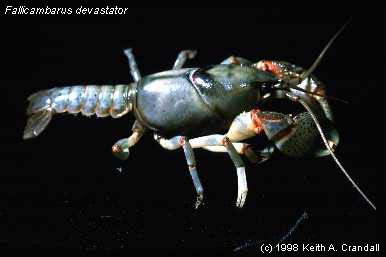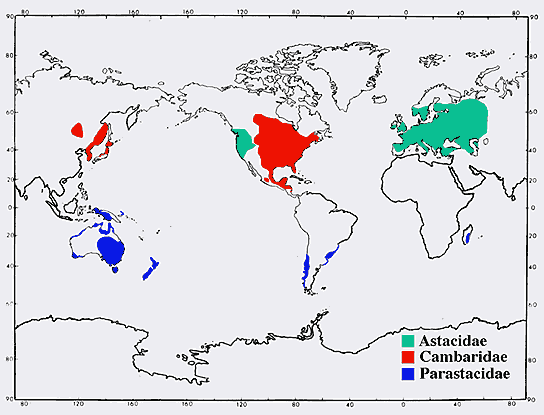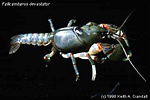Astacidea
Freshwater crayfish
Keith A. Crandall and James W. Fetzner, Jr.


This tree diagram shows the relationships between several groups of organisms.
The root of the current tree connects the organisms featured in this tree to their containing group and the rest of the Tree of Life. The basal branching point in the tree represents the ancestor of the other groups in the tree. This ancestor diversified over time into several descendent subgroups, which are represented as internal nodes and terminal taxa to the right.

You can click on the root to travel down the Tree of Life all the way to the root of all Life, and you can click on the names of descendent subgroups to travel up the Tree of Life all the way to individual species.
For more information on ToL tree formatting, please see Interpreting the Tree or Classification. To learn more about phylogenetic trees, please visit our Phylogenetic Biology pages.
close boxIntroduction
Freshwater crayfishes are taxonomically distributed among three families; two Northern Hemisphere families, Astacidae and Cambaridae and one Southern Hemisphere family, Parastacidae. There are two centers of species diversity for freshwater crayfishes. The first is located in the Southeastern United States where some 80% of the cambarid species can be found. The second center of diversity is in Victoria, Australia; housing a large proportion of the parastacid species. Freshwater crayfishes naturally occur on all of the continents except Africa (Figure 1). The Astacidae are distributed West of the Rocky Mountains in the Northwest United States into British Columbia, Canada and in Europe. The Cambaridae are found in the Eastern United States and south through Mexico. The Parastacidae are distributed in Australia, New Zealand, South America, and Madagascar.
Discussion of Phylogenetic Relationships
The phylogenetic relationships among the freshwater crayfish families and their relationships to lobster-like ancestors has been of considerable debate for at least 100 years. Two alternative hypotheses have been proposed for the origins of crayfishes. The first supposes a diphyletic origin of astacoids and parastacoids suggesting independent invasion of the freshwater habitat (Huxley, 1880). This idea is supported by the two centers of diversity in the northern and southern hemispheres and by a number of morphological features (Hobbs, 1974). However, Ortmann (1902) argued for a monophyletic origin of the crayfishes. This position has recently been supported by sperm ultrastructure characteristics (Jamieson, 1991) and by embryonic characters (Scholtz, 1993). Because of this ongoing debate, the positioning of Parastacidae is shown as unresolved.
References
Crandall, Keith A., D. James Harris, James W. Fetzner, Jr. 2000. The Monophyletic Origin of Freshwater Crayfish Estimated from Nuclear and Mitochondrial DNA sequences. Proc. R. Soc. Lond. B (2000) 267, 1679-1686.
Hobbs, H.H., Jr. 1974. Synopsis of the families and genera of crayfishes (Crustacea: Decapoda). Smithsonian Contributions to Zoology 164:1-32.
Hobbs, H.H., Jr. 1988. Crayfish distribution, adaptive radiation and evolution. Pp. 52-82 in D.M. Holdich and R.S. Lowery (eds), Freshwater crayfish: biology, management and exploitation. Timber Press, Portland.
Huxley, T.H. 1880. The crayfish: An introduction to the study of Zoology. D. Appleton, New York.
Jamieson, B.G.M. 1991. Ultrastructure and phylogeny of crustacean spermatozoa. Memoirs of the Queensland Museum 31:109-142.
Ortmann, A.E. 1902. The geographical distribution of freshwater decapods and its bearing upon ancient geography. Proceedings of the American Philosophical Society 41:267-400.
Scholtz, G. 1993. Teloblasts in decapod embryos: an embryonic character reveals the monophyletic origin of freshwater crayfishes (Crustacea, Decapoda). Zool. Anz. 230:s45-54.
Scholtz, G. 1998. Von Zellen und Kontinenten-die Evolution der Flußkrebse (Decapoda, Astacidae). Neue Folge Nr. 137, 205-212.
Scholtz, G. & Richter S. 1995. Phylogenetic systematics of the reptantian Decapoda (Crustacea, Malacostraca). Zool. F. Linn. Soc. 113, 289-328.
Scholtz, V. G. 1995 Ursprung und Evolution der Flußkrebse (Crustacea, Astacida). Sitzungsberichte Gesellschaft Naturforschender Freunde Berlin 34, 93-115.
Title Illustrations

| Scientific Name | Fallicambarus devastator |
|---|---|
| Image Use |
 This media file is licensed under the Creative Commons Attribution-NonCommercial-ShareAlike License - Version 3.0. This media file is licensed under the Creative Commons Attribution-NonCommercial-ShareAlike License - Version 3.0.
|
| Copyright |
© 1998 Keith A. Crandall

|
About This Page
Keith A. Crandall

Brigham Young University, Provo, Utah, USA
James W. Fetzner, Jr.

Carnegie Museum of Natural History, Pittsburgh, Pennsylvania, USA
Page copyright © 2010 Keith A. Crandall and James W. Fetzner, Jr.
 Page: Tree of Life
Astacidea. Freshwater crayfish.
Authored by
Keith A. Crandall and James W. Fetzner, Jr..
The TEXT of this page is licensed under the
Creative Commons Attribution-NonCommercial-ShareAlike License - Version 3.0. Note that images and other media
featured on this page are each governed by their own license, and they may or may not be available
for reuse. Click on an image or a media link to access the media data window, which provides the
relevant licensing information. For the general terms and conditions of ToL material reuse and
redistribution, please see the Tree of Life Copyright
Policies.
Page: Tree of Life
Astacidea. Freshwater crayfish.
Authored by
Keith A. Crandall and James W. Fetzner, Jr..
The TEXT of this page is licensed under the
Creative Commons Attribution-NonCommercial-ShareAlike License - Version 3.0. Note that images and other media
featured on this page are each governed by their own license, and they may or may not be available
for reuse. Click on an image or a media link to access the media data window, which provides the
relevant licensing information. For the general terms and conditions of ToL material reuse and
redistribution, please see the Tree of Life Copyright
Policies.
- First online 01 June 1995
- Content changed 11 March 2010
Citing this page:
Crandall, Keith A. and James W. Fetzner, Jr. 2010. Astacidea. Freshwater crayfish. Version 11 March 2010 (under construction). http://tolweb.org/Astacidea/6655/2010.03.11 in The Tree of Life Web Project, http://tolweb.org/








 Go to quick links
Go to quick search
Go to navigation for this section of the ToL site
Go to detailed links for the ToL site
Go to quick links
Go to quick search
Go to navigation for this section of the ToL site
Go to detailed links for the ToL site